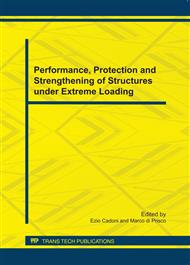p.314
p.320
p.326
p.332
p.338
p.344
p.350
p.356
p.362
Shock Loads Induced on Metal Structures by LHC Proton Beams: Modelling of Thermo-Mechanical Effects
Abstract:
In this work, the numerical simulations of the LHC high energy particle beam impact against a metal structure are performed using the commercial FEM code LS-DYNA. The evaluation of thermal loads on the hit material is performed using a statistical code, called FLUKA, based on the Monte-Carlo method, which returns an energy map on a particular geometry (taking into account all the particles in the cascade generated by the interaction between the proton beam and the target). The FLUKA results are then used as input for thermo-structural studies. The first step of this work is the validation of the numerical procedure on a simple geometry for two different materials (copper and tungsten) and constitutive material models. In particular, the high energy particle impact is examined on a facially irradiated cylindrical bar: the beam hits the component directly on the centre of the basis. Then the final step is the study of the impact on a real structure with an energy beam of 5 TeV (the next target in the energy value of LHC beam).
Info:
Periodical:
Pages:
338-343
Citation:
Online since:
July 2011
Keywords:
Price:
Сopyright:
© 2011 Trans Tech Publications Ltd. All Rights Reserved
Share:
Citation:


